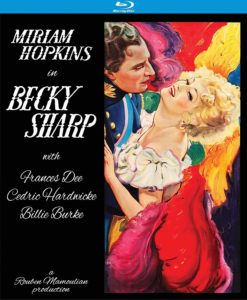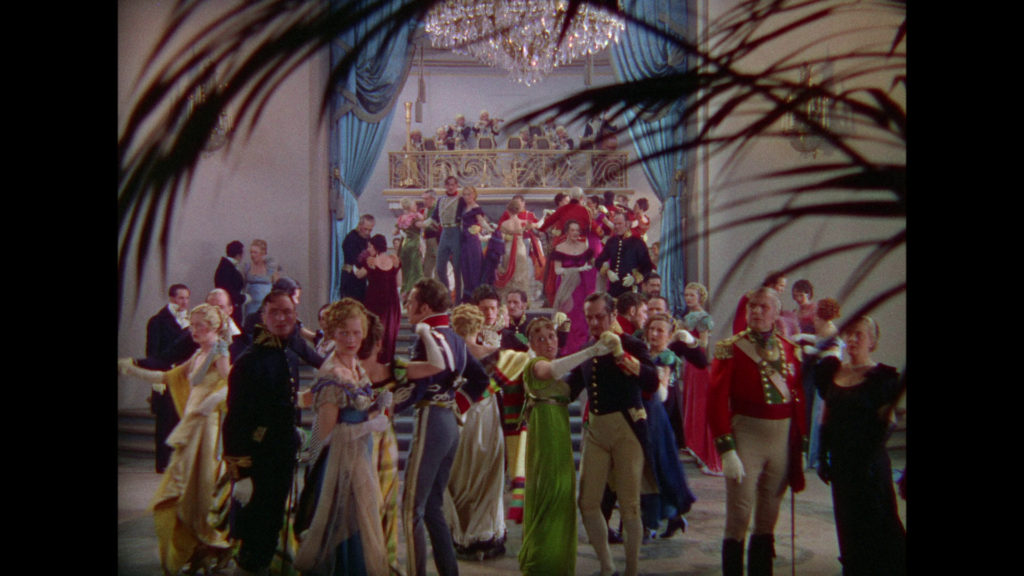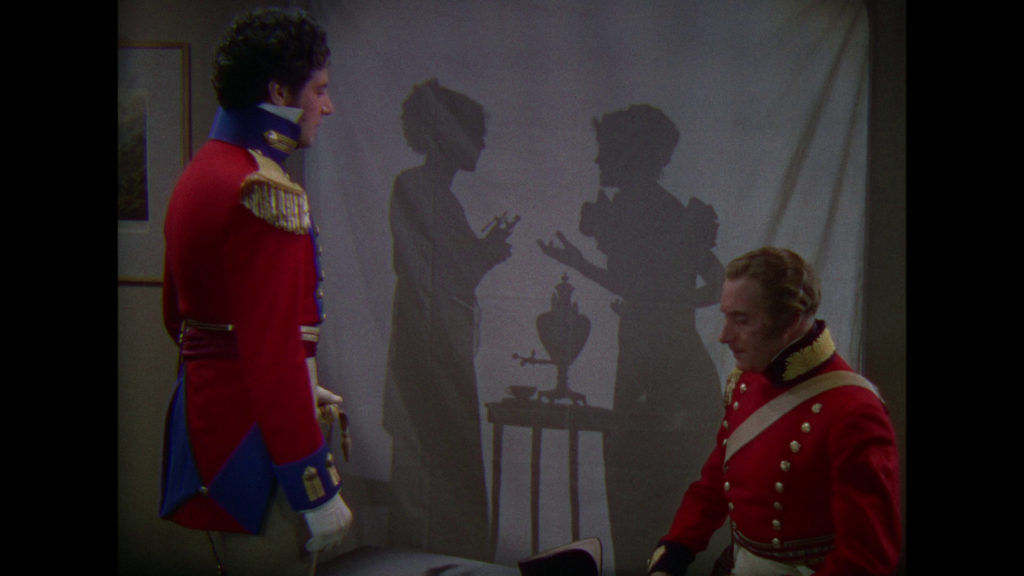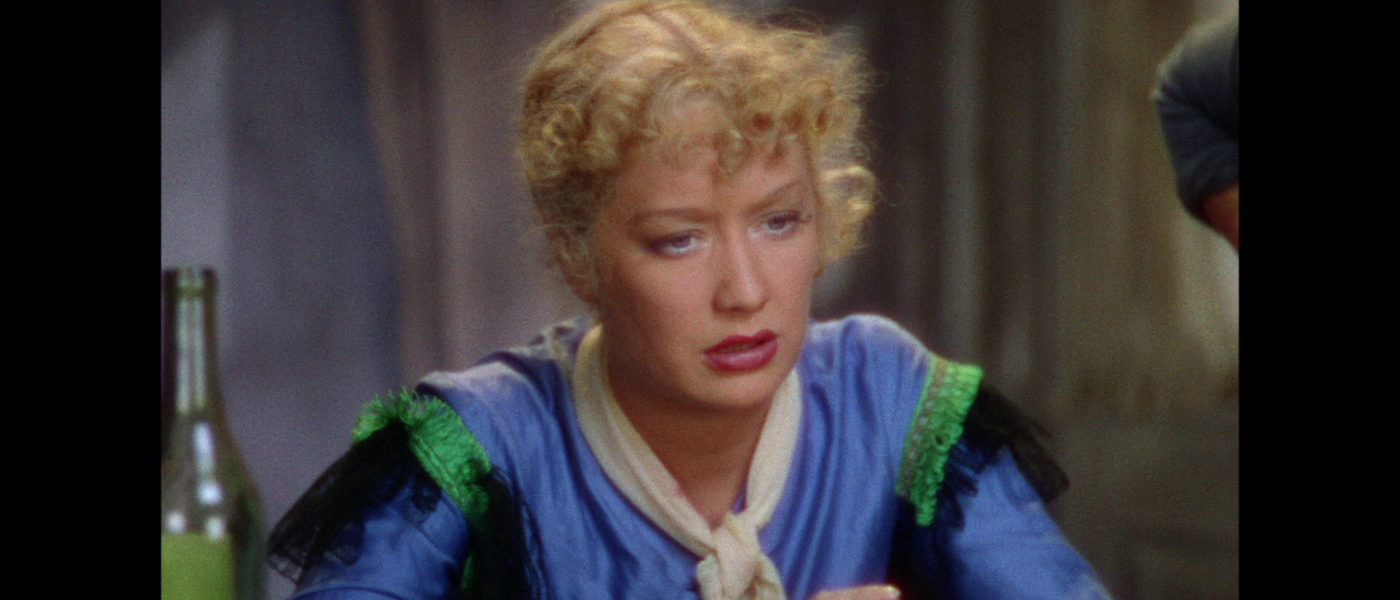First Three-strip Technicolor Feature Film is Indeed a Vanity Fair.
DIRECTED BY ROUBEN MAMOULIAN/1935
BLU-RAY STREET DATE: APRIL 16, 2019/KINO LORBER STUDO CLASSICS

How sharp is Becky? As sharp as she needs to be, and then some. But then, early 1800s England is a tough place to be a young woman facing her future, so you might add “feisty” and even “conniving” to the list. But “sharp”, being her name and all, is, appropriately, the main thing.
1930s acting sensation Miriam Hopkins (Design for Living), in the title role, fully carries Becky Sharp onscreen. Hopkins’s Sharp is as admirably confident as she is terribly scheming, generating sympathy with her crocodile tears and her ability to manipulate any situation with her turn-on-a-dime waterworks. In a culture where women find themselves at the mercy of their own born-in class and their own ability to climb the social ladder, one-time lower tiered Becky is an expert success story. Hopkins’s performance goes a long way in making the character’s selfish mechanizations palatable.
Based upon William Makepeace Thackeray’s 1847 novel, Vanity Fair, Becky Sharp not just re-enacts history (the cynical romance is set around the battle of Waterloo) but is historically significant in its own right for being the first feature-length film shot and released in glorious three-strip Technicolor. Everything from gala upper-class soirées to simple drawing room are punctuated with eye-popping vibrant fashions. If Thackeray’s story was a literary version of its own initial subtitle, a “Pen and Pencil Sketches of English Society”, then the film version is a precisely painted panoply rendered on a short canvas.

As film buffs know, Technicolor is perhaps the height of Hollywood dream life writ large, though the years have not been kind to the delicate surviving elements. For many years, the true and absolute grandeur of the once-reigning rainbow process was a faded and grainy memory. Only in recent decades have restoration efforts made it possible to experience a select few Technicolor spectacles the way they were originally intended.
But, for every Gone with the Wind and The Wizard of Oz that is pristinely time-vaulted, there are many Becky Sharps only now being salvaged, if that. In this case, though this new Blu-ray edition from KL Studio Classics is an unquestionable keeper, even numerous restorations over the years have not been able to save all of Becky Sharp. While much of the film, sourced from a brand new 4K restoration from the 35mm nitrate negative & positive separations, looks stunningly impeccable, certain reels were apparently not salvageable. For the most part, the resulting high definition image passes muster. Only with the final reel do the visuals take a hard turn into the toilet, shifting from nearly perfect to distractingly deteriorated.
If anyone is truly sharp, it’s the film’s director, Rouben Mamoulian. Having proven himself a visual storytelling marvel with his 1931 adaptation of Dr. Jekyll and Mr. Hyde, Love Me Tonight the following year, and most pronounced in this case, his groundbreaking acumen on the early talkie, Applause (1929). With these films, and others, Mamoulian proved that the advent of sound on film was, in fact, not the artistic death of cinema as a visual medium.

Replacing director Lowell Sherman, who’d fallen sick and then died, Mamoulian is said to have started all over again with Becky Sharp, making the film entirely his own. Therefore, since no Sherman footage is included, that can’t be the reason why the film falls back on staged and static microphone-favoring actor lineups and whatnot. Rather, it’s the application of the three-strip Technicolor that he focuses the visual part of his job. And this is where Mamoulian is so sharp- rather than slather the frame with bright flashy colors just because he can (a garish temptation that many other filmmakers of the time would lean into), he’s quite conservative about it, allowing it to punctuate and underscore the emotional themes- much the way he used bold camera work in his aforementioned work.
Co-starring Frances Dee, Cedric Hardwicke and Nigel Bruce, this modest Pioneer Studios super-production (i.e., lavish sans massive scope; entirely interiors, in fact) isn’t the uneven slog that some say. Wringing with attitude, courtesy of Hopkins’s spot-on performance, and moving through its years quickly at a taut eighty-four minutes, it’s conceivable that Becky Sharp left some viewers in the dust. Fortunately, Kino Lorber provides a terrific audio commentary by film historian Jack Theakston. Theakston’s clearly done his homework, his depth of knowledge engaging and impressive.
As the first sounding of what would become the battle of Waterloo occurs, an upper crust formal gathering hauntingly shifts from obliviousness to denial to panic within seconds, brilliantly depicted with the forceful bursting open of a pair of large balcony doors. Lights are suddenly extinguished, immediately shifting the tone from blissfully cloistered to dimly uncertain. Mamoulian expertly captures the sudden terror of this imposing violent reality, thus equalizing the wealthy and the main character’s true standing and everything in-between, in one fell swoop. This most memorable moment alone validates picking up Becky Sharp on Blu-ray, though the rest is plenty pointed, as well.
The images used in this review are credited to DVDBeaver and are taken directly from Kino Lorber’s Blu-ray release.


